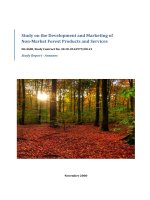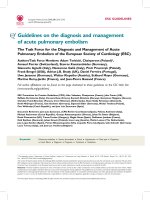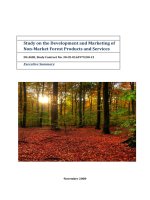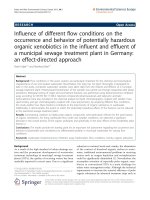Research study on the trends and patterns of corporate giving to charities in singapore
Bạn đang xem bản rút gọn của tài liệu. Xem và tải ngay bản đầy đủ của tài liệu tại đây (849.25 KB, 239 trang )
RESEARCH STUDY ON THE TRENDS AND PATTERNS OF
CORPORATE GIVING TO CHARITIES IN SINGAPORE
TAN BEE WAN
NATIONAL UNIVERSITY OF SINGAPORE
2005
ii
RESEARCH STUDY ON THE TRENDS AND PATTERNS OF CORPORATE
GIVING TO CHARITIES IN SINGAPORE
TAN BEE WAN
(BA, University of Singapore, MA in Social Welfare, University of Wisconsin- Milwaukee)
A DISSERTATION
SUBMITTED TO THE FACULTY OF
ARTS AND SOCIAL SCIENCES
IN PARTIAL FULFILLMENT OF THE REQUIREMENTS FOR THE DEGREE OF
DOCTOR OF PHILOSOPHY
DEPARTMENT OF SOCIAL WORK AND PSYCHOLOGY,
NATIONAL UNIVERSITY OF SINGAPORE
MARCH 2005
iii
Copyright © 2005 by Tan Bee Wan
ALL RIGHTS RESERVED
iv
TO MY MENTOR, THE LATE DR. EE PENG LIANG,
MY LATE PARENTS,
MR. TAN TEONG SOO AND MDM. TEH LYE NEO,
AND CHILDREN,
KATHLEEN AND MARLENE DITZIG
v
Acknowledgement
This study would never come into being if it were not for a collection of people
who thought that the whole exercise was worthwhile – particularly when the researcher
begins to doubt it. I must therefore pay tribute, once again, to my remarkable supervisor
and mentor, Assoc. Professor, S.Vasoo, of the Department of Social Work & Psychology,
National University of Singapore, for his continuing belief in me and for his
encouragement to persist in the study. His scholarly insights and practical suggestions
helped me immensely in framing my work and his excellent supervision and guidance
ensures the completion of the dissertation.
I would also like to express my deepest gratitude to the late Mr. Charity, Dr. Ee
Peng Liang, whose demonstration of kindness and love for the needy, has ignited in me
the passion to raise funds and serve people in need.
I wish to record my deep appreciation to all the Chief Executive Officers (CEOs),
Human Resource (HR) Directors, Volunteer Leaders, and Mrs. Tan Chee Koon, Chief
Executive Officer, of National Volunteer and Philanthropy Centre, for their astute
comments and strong support in helping me to collect and make sense of my data. Also,
I am very appreciative of the help rendered by my two research assistants, Ms. Ng Ming
Yuet, Ms. Germaine Tay, and Ms. Goh Fang Ying for their patience in helping me in
data-collection and typing the drafts of the dissertation.
I am very grateful to Professor Ann Wee, of the Department of Social Work and
Psychology, National University of Singapore, and Dr. Ngiam Tee Liang, Head,
Department of Social Work & Psychology, National University of Singapore, for their
endorsement and assistance to enable me to embark on the study.
vi
Finally, I would like to acknowledge the authors listed in the bibliography, whose
work has helped me in my research on corporate philanthropy. But I realize that my
ideas come from somewhere else, even if I am not always conscious of it. Therefore, I
want to express my gratitude to all those who have educated and enriched my study, by
their suggestions or examples. That includes my family, friends and colleagues at
Integrative Learning Corporation, who have taught me as much or more than I shared
with them on philanthropy.
In summary, my quest for Corporate Philanthropy is:
“Building a Community to withstand the storms of life.”
vii
Table of Content
DEDICATION………………………………………………………………………. iv
ACKNOWLEDGEMENTS…………………………………………………………. v
TABLE OF CONTENT……………………………………………………………… vii
ABSTRACT…………………………………………………………………… ix
LIST OF TABLES………………………………………………………………… xi
LIST OF FIGURES…………………………………………………………………. xiii
CHAPTER 1: TRENDS AND GROWTH OF CORPORATE PHILANTHROPHY
Introduction……………………………………………………………… 1
1. 1 Key Issues & Growth of Corporate Philanthropy…………………… 3
1.2 Motivations in Giving………………………………………………… 8
1.3 Types of Gifts………………………………………………………… 19
1.4 Trends of Corporate Philanthropy …………………………………… 27
CHAPTER 2: THE GROWTH OF CORPORATE GIVING IN SINGAPORE
Introduction……………………………………………………………… 31
2.1 A Historical Overview of Corporate Giving in Singapore……… …… 31
2.2 Understanding the Trends of Corporate…………………………….…. 45
CHAPTER 3: A LITERATURE REVIEW ON PERSPECTIVES OF CORPORATE
GIVING
Introduction……………………………………………………………… 52
3.1 Theories of Giving…………………………………………………… 53
3.2 Trends and Motivations in Corporate Giving.……………………….… 59
3.3 Reviewing Models of Corporate Giving…………………………….… 64
3.4 Applications of Models for Research Study…………………………… 79
CHAPTER 4: RESEARCH METHODOLOGY AND DESIGN
Introduction……………………………………………………………… 84
4.1 Research Methods…………………………………………………… 84
4.2 The Research Design………………………………………………… 88
4.3 Statistical Analysis of the Data…………………………………….… 99
viii
4.4 Limitations of the Study………………………………………………. 100
CHAPTER 5: FINDINGS AND ANALYSIS
Introduction…………………………………………………………….… 103
5.1 Profile Companies in the Study……………………………………… 106
5.2 Analysis of poltical and Economic Variables of Corporate Giving.…. 112
5.3 The Dynamics of Decision-Making on Corporate Donations……… 122
5.4 Philanthropy as a Social Currency…………………………………… 129
5.5 Summary…………………………………………………………… 141
CHAPTER 6: THE CORPORATE LEADERS PERSPECTIVES ON CORPORATE
PHILANTHROPY
Introduction…………………………………………………………… 148
6.1 Analysis of Qualitative Data……………………………………… 149
6.2 Summary…………………………………………………………… 167
CHAPTER 7: IMPLICATIONS AND RECOMMENDATIONS FOR POLICY AND
PRACTICE
Introduction………………………………………………………………… 172
7.1 Summary of the Findings………………………………………………. 173
7.2 Trends of Corporate Giving……………………………………………. 174
7.3 Implications for Charities………………………………………………. 180
7.4 Implications for Policy Makers………………………………………… 182
7.5 Implications for Future Research………………………………………. 184
7.6 Conclusions…………………………………………………………… 186
REFERENCES ……………………………………………………………… 190
APPENDICES
Appendix 1: Letter to Companies to Participate in Survey………………………. 209
Appendix 2: Questionnaire on the Study of Trends and Patterns of Corporate
Philanthropy in Singapore…………………………………………… 210
Appendix 3: List of Participating Companies ……………………………………. 222
Appendix 4: Letter to CEO and Interview Schedule …………….……………… 224
Appendix 5: List of Interviewees…………………………………………………. 227
ix
Abstract
This pioneer study attempts to examine the growth of corporate philanthropy and
the motivation behind corporate giving in Singapore. Understanding these critical aspects
are important to local policy makers and charity organizations as it will provide empirical
data for making decisions in taking corporate philanthropy to new heights. Motivations
behind corporate giving, types of gifts, as well as growth in corporate philanthropy in
Singapore vis-à-vis historical origins, demographic shifts, social development, and
cultural belief are examined. A chronological review of available literature on corporate
philanthropy in the United States, Europe, and other parts of the world uncovers four
interrelated concepts namely, philanthropy, altruism, charity, and voluntarism. Four well-
established models of corporate philanthropy are discussed – Altruistic, Profit-
Maximizing; Political, and Stakeholder.
To examine the dynamics and motivations of giving specific to Singapore, the
following hypotheses are tested and they cover: the speed and extent of growth in
corporate philanthropy will depend on the motivations of the Chairman/CEO towards
charitable contributions; the decision-makers’ attitude towards corporate giving is
motivated by his/her own beliefs and values towards charity, peer influence and the
cultural context that he/she is operating in.
Through qualitative and quantitative research methods, the results of this study
show several key findings. It is found that corporate philanthropy in Singapore is
positively correlated with profitability. While the conditions of business or its
performance may affect the level of contributions, there is little evidence to show any
decrease in corporate giving due to decreases in business. Large corporations are more
x
likely to view philanthropy as a form of strategic investment and contributed the most to
charities in absolute dollars, but not in terms of the percentage of their profits. This is
consistent to findings with trends in the USA and Great Britain. There is some evidence
of a positive correlation between level of contribution and the types of causes that have
been supported – more donations have been channeled to community organizations rather
than to charitable organizations. Tax incentive is not a strong motivator for corporate
giving in Singapore.
A significant percentage of senior management personnel are
actively involved in the distribution function of corporate giving, preferring to give on an
ad hoc basis suggesting “personalism” rather than professionalism. One surprising
finding is that the Singapore sample indicated that they are not motivated by having to
follow the industry or business network norms of giving, but rather by personal
solicitation to give, especially by solicitors of influence.
Corporate giving in Singapore will increase over the years but will move towards
strategic philanthropy rather than altruistic giving; and corporate donors will expect
returns on their donations such as tax exemption, recognition by government, and other
goodwill valuable to them. The survey also found that personal values of the decision-
makers are increasingly influential in shaping corporate philanthropy. Hence, an in-depth
understanding of the social-psychological forces that influence and shape the CEOs’
attitudes towards giving needs to be undertaken as these factors are essential to the
development of corporate philanthropy in Singapore
xi
List of Tables
Table Description Page
1.1 Classification of Sample by Industries 107
1.2
Company Size and Status 108
1.3 Contributions to Charity by Industries in Year 2000 109
2.1 Analysis of Contribution by Industry Classifications 113
2.2 Contributions to Charities by Net Profit in Year 2000 115
2.2A Pearson Correlation 117
2.3 Tax Incentive as a Condition for Company Contributions 118
2.4 Contributions by Size of Companies 120
3.1 Decision- Making in Contributions Function 123
3.2 Participation in Decision-making Process 124
3.3 Contribution Functions and Strategic Goals 126
3.4 Companies’ Methodologies towards Funds Allocation 127
3.5 Criteria for Donations 128
3.6 Motivations and Corporate Philanthropy 130
4.1 Ranking of Personal Values towards Giving 136
(Singapore Study)
4.2 Types of Charitable Contribution From Payroll Deduction
in Year 2000 137
xii
List of Figures
Figure Description Page
1(a) Trends of Giving From 1997-2000 110
1(b) Trends of Giving From 2001-2003 111
2(a) Distribution of Roles Played By Senior 120
Management in Contribution Functions
3(a) Motivators by Degree of Motivation 131
3(b) Comparisons of the Characteristics of 134
Personal Values towards Giving – Singapore
vs. USA study
4 The Three Components of Corporate Citizenship 145
Research Study on the Trends 13
Chapter 1: Trends and Growth of Corporate Philanthropy
Introduction
Corporations have varying ability to give and support charitable causes. They
stand to gain substantially, both in the short term and in long run, from a healthy
community and productive workforce. Yet, many corporations worldwide have given
little support to charities.
In Singapore, the top 200 most profitable companies in 1999 and 2000 have given
less than 0.01 percent of their net profits to charitable causes, based on annual statements
of accounts of 200 most profitable companies in Singapore for 1999 –2000. In the Straits
Times’ nation-wide appeal for the Pocket Money Fund and the Duck Race in 1999 and
2000, corporate donations form less than 10% of the entire funds raised. According to a
National Volunteer and Philanthropy Centre’s survey of 2,450 Singapore businesses
between June and October 2004, corporate donations have increased to 0.21 per cent of
their pre-tax profits in 2003. This seems to be a significant though slight increase in
corporate charitable giving. Compared to other developed countries like United States
(1.6% in 2003), Canada (1.03% in 2001), and United Kingdom (0.95% in 2002),
Singapore corporate giving can be improved. Mrs. Tan Chee Koon, said:
“The 0.21 per cent gives cause for serious reflection. From the look of things,
companies can certainly afford to be more generous.” (The Straits Time, Jan 14
th
2005).
We, therefore, need to understand some of the underlying reasons for such poor
responses and examine the driving forces behind corporate giving. It is also pertinent to
study why some companies give and some do not. Understanding the dynamics and
motivations of giving will help charities in Singapore to enhance corporate philanthropy.
Research Study on the Trends 14
Communities will stand to benefit in the long run if both charities and corporations
develop a mutually beneficial relationship of giving and receivership.
In the last decade, interests in corporate citizenship and responsibility have begun
to exert unprecedented influence on business operations. Businesses are taking a keen
interest in wider issues such as environmental protection, donor support, quality of life
and human rights. Close attention is paid to how businesses meet human needs; the need
to create a bond between its customers and its constituencies, and promote good
corporate health as well as betterment of the larger community. The chairman of Exxon,
which is one of the largest philanthropic donors in the United States, Mr. C.C. Gavin, Jr.,
expressed the thought succinctly in these words:
“Business does best in communities that are healthy, alive and secure. To stay in
business, we have to make a profit. To succeed in business, we have to share some of that
profit for the public good.” (April 1982, p.34).
Many diverse global companies such as General Electric, Procter & Gamble, IBM,
Coco-Cola, Shell International Limited, America Express, Citigroup, have publicly
declared and shown their social responsibilities through philanthropic and volunteer
efforts. These public testimonies by successful companies to demonstrate good corporate
citizenship, inevitably, set the pace for other companies to be seen and be actively
involved in corporate philanthropy.
The notion of corporate philanthropy has a longer historical development than
corporate citizenship. It has been in existence since 1900s, as many companies have been
engaged in specific charitable causes such as prevention of infant mortality, poverty and
diseases. However, it is only in the last decade that corporate philanthropy seems to be
Research Study on the Trends 15
activated. Researchers and practitioners of corporate philanthropy have identified some
of the main “push” factors that steer corporations into being socially responsible.
In this chapter, the literature on the issues and growth of corporate philanthropy
will be examined, the prevailing theoretical frameworks for studying corporate
philanthropy will be discussed, and a suitable theoretical framework developed for this
study will be presented.
1.1 Key Issues and Growth of Corporate Philanthropy
The growth of corporate philanthropy is attributed to a few factors, namely,
resurgence of civil society initiatives, globalization of business and scale of social needs
and problems, emergence of enlightened corporate leadership in conjunction with the
development of the new economy and its impact on corporate philanthropy. Each of these
factors will be discussed.
The Resurgence of Civil Society Initiatives.
Several researchers have attributed
the resurgence of civil society initiatives, especially in the Western economies, to the
growth of corporate philanthropy. Changing expectations concerning corporate roles has
led advocacy groups to demand for more social responsiveness from businesses. (Turner,
1968; Baker & Shillingburg, 1977; Levy & Shatto, 1978; Maddox, 1981). Several
surveys have shown that consumers are demanding that corporations be responsive to
environmental and consumers’ well being. These have been pointed out in the following
surveys conducted by the New York Times, 1994 MORI (a U.K. public survey company),
1997 Lucent Technologies, and 1997 Cause-Related Marketing Trends Report. Most of
them concluded that as customers become more educated, their expectations of the
companies and its products also change. Customers are likely to protest against a
Research Study on the Trends 16
company by ceasing to buy its products on behalf of being “green” and “ethical” and
avoid using the services or products of a company they considered to have a poor
environmental record. They demand better services, higher quality and lower prices from
products, and expect companies to give back to the community. This has led to
corporations being more conscious of the need to be seen as good corporate citizens by
participating in and endorsing community projects in return for goodwill.
Globalization of Business and Scale of Social Needs and Problems.
Researchers
have identified two major changes that propel the rise of corporate philanthropy – the
growing complexity and increasing intertwining between economics and social issues as
business globalizes, and the types of social needs and problems becoming more complex.
With the end of the Cold War and the increasing dependence on technology,
international power structure has shifted from political and defense base to that of
economics and business. Many major corporations, such as Microsoft, General Electric,
and Shell International, already control more wealth than the average GNP of a
developing nation. To continue to maintain their wealth, these corporations have to
expand their businesses to the entire world. As they move through this expanded horizon,
businesses will face many of the world’s most serious problems.
The continued persistency of illiteracy, the growing gap between the rich and
poor, the pressures of unregulated immigration all have the potential to destabilize the
economies upon which development and growth depend. Governments which are
incapable of meeting their citizens’ immediate needs for food, shelter, and employment,
will inevitably look to the corporations, local and foreign, operating in its community to
assist. No one business has sufficient resources to succeed single-handedly to resolve
Research Study on the Trends 17
these difficulties. In this context, they will have to collaborate and partner with other
companies in various parts of the world to tackle these challenges.
This trend is reflected in the work of international donor agencies like Ford
Foundation, Rockefeller Brothers Fund, and the Prince of Wales Business Leaders Forum.
The major focus of these agencies has shifted from merely contributing to programmes,
to strengthening corporate resources for nonprofit organizations. Likewise, current
programmes initiated by the International Association for Volunteer Effort (IAVE) and
Rotary International are aimed at mobilizing resources from various advanced countries
to promote corporate participation across the boundaries.
Another recent and very interesting school of thought on the rise of corporate
philanthropy is the birth of a new breed of technocrat millionaires. Studies of these major
donors’ behaviors have become increasingly important, as they have transformed the
entire social landscape of corporate leadership in philanthropic giving. (Schervish,
O’Herligy & Havens, 2000; Greenfeld, 2000).
Emergence of Enlightened Corporate Leadership in the New Economy and its
Impact on Corporate Philanthropy. The new “e-economy” is predestined to change the
shape of charitable giving and swift responses and changes to donor trends can be
expected. It took 50 American and Fortune 500 companies two years to collectively
donate US$1.8 billion to charity. Within two years, in February 2000, it took only two
persons – Ted Turner and Bill Gates to give US$2 billion to charity. (Conlin. M., Gard. L,
and Hempel, 2004).
Just as information technology has rapidly changed the way that people
communicate and their lifestyles over the last decade, the emergence of a new class of
Research Study on the Trends 18
young, high-tech millionaires has significantly changed the scene of corporate
philanthropy in the United States and globally.
Several researchers and reports (Time, July 24, 2000; Business Week, November
29, 2004) have described past generation of corporate philanthropists, such as The
Rockefellers and Carnegies, as being less democratically-minded than today’s up-and-
coming high-tech donors. They were more inclined to control and be focused in their
charitable giving. Whereas high-tech philanthropists, such as Bill Gates, Walter Hewlett,
Ted Turner and others, are more likely to support global agendas and application of
intellectual capital or new ideas. They are more interested in the differences that their
dollars can make than just supporting worthy causes. Unlike philanthropists in the past,
who built up money slowly and gave it away late in life, these young nouveau-riche are
adopting a hands-on approach to giving, adopting charities as “partners” and watching
outcomes of their contributions more closely. (Time, July 24, Vol. 156, No.4, 2000)
These changing behaviors and expectations of these major corporate donors will have
tremendous implications on the directions of corporate giving and funding of the non-
profit sector. More importantly, these substantial donations by the new rich have led to
impressive jump in major donations, despite the burst of the internet business bubble and
signs of a sliding economy, as observed by Patrick Rooney, Director of Research, The
Centre for Philanthropy at Indiana University (The Straits Times, May 8
th
2001).
The new philanthropy as embraced by the new rich and the leaders of the new
economy are characterized by pushing of big ideas, focusing on global rather than local
issues, leveraging resources, and personal formulas for giving. There are several schools
Research Study on the Trends 19
of thoughts on why the e-world philanthropists thinking, expectations, and behaviors are
so different from the “old” economy rich.
Sedgwick (2004) proposes that the key driver is the ethos of the new economy,
where making money and giving away money is perceived as an act of inventing and
solving problems, not as two antithetical operations. The new rich just love inventing
new and big things and be personally involved in solving problems. Just as these
entrepreneurs thrive on risks and strive for fast bucks and returns of investment, they
apply the same principles to their investment in philanthropy. Unlike in the old economy
where corporate giving to community is a tradition of the corporation, following the rules
and regulations of the companies and the community, the interests of the new
philanthropists are usually guided by personal reasons. This attitude is aptly summed by
one of the leading new economy philanthropists, Steve Kirsch who said (Sedgwick,
2004):
“Enlightened self-interest. What I do may appear to be for unselfish reasons, but
actually it’s for me and for the people close to me, my family especially.”
Hence, researchers and practitioners studying the dynamics of corporate
philanthropy, are now delving deeper into the motivation behind the key decision-
makers’ charitable behaviors. Understanding these major corporate donors’ motivation to
giving is a critical area of research in corporate philanthropy as they usually form 80% of
the total corporate giving in any community. They also set the pace and roles of
leadership in corporate giving, not only locally but also regionally and globally.
Research Study on the Trends 20
1.2 Motivations in Giving
We need to look into the real motives and purposes of corporate giving. This is a
challenging issue to examine and is critical to understand factors influencing giving in the
field of corporate philanthropy.
In an American 1948 public opinion study conducted by the Opinion Research
Corporation, on attitudes of the general public, of community leaders, and of
stockholders on corporation giving, it was found that most of the people sampled are
supportive of corporate giving. 80 per cent of the general public approved corporate-
giving to charitable causes and only 5 per cent definitely disapproved. When the same
was asked of a group of community leaders, teachers, clergymen, lawyers, editors, 78 per
cent favoured and 7 per cent were against, with 5 per cent qualified support and 10 per
cent no opinion. When the question was narrowed to those community leaders who hold
stocks, substantially no difference was shown: 76 per cent for, and 8 per cent opposed.
Under the still more searching question, “Should officers in the company in which you
own stock give company money to charitable causes?” the favorable votes declined to 62
per cent and the negative rose to 13 per cent; reflecting a relatively strong approving
sentiment.
This survey also indicated that the degree of support for donation to charitable
causes decreased as the stakeholders’ interest in the company increased. What are the
reasons that led to this change in attitude towards giving? Is it the lack of altruism,
uncertainty on how officers donate to charitable causes, or could not see how
contributions were directly related to corporate or employee benefits?
Research Study on the Trends 21
While the issue on motivations of giving is still being studied, several researches
have shown that corporate giving is undoubtedly influenced by mixed motives. It is not
based on pure altruism. It is more likely to be due to enlightened selfishness, i.e.
corporations believe that their contributions will be beneficial in one form or another to
their companies and donors. While there is no conclusive evidence that this is the key
motivator, there are more findings which support the theory that with the growing
complexity of the business environment, corporations will be embroiled in some
legislative, legal, labor, community or product controversy at some point during their
existence. This is reflected as early as 1950s by Andrews (1956) a pioneer in the study of
corporate philanthropy, when he concluded that however broad their charters were,
“contribution” programmes by companies tended to benefit companies more than the
welfare of mankind.
It will be useful to find what are the key factors and motivators that promote
corporate giving. This provides a critical analysis of the patterns of philanthropy of major
corporations in Singapore.
Key Factors Influencing Charitable Giving.
Based on a 1948 study of 326
American corporations by the Russell Sage Foundation, the following were identified as
key factors influencing gifts: size of company, number of employees, type of industry,
donations and business cycles, motives and purposes of giving, level of involvement with
charitable organizations, symbols of corporate success and affluence, and personal values
of key corporate decision-makers.
Research Study on the Trends 22
A summary of these key factors are as follows:
• the bigger the companies, the lower their rate of charitable giving;
• the highest level of giving in proportion to net income occurs in smaller
corporations with few employees (less than 50) and the lowest in the
larger corporations;
• the amount of contribution and the decision whether to contribute at all
is in many cases largely determined by the actions of other members of
the same subgroup i.e. within the same sector; “duty to community” is
seen as the key motivation and purpose influencing gifts;
• the higher the level of involvement with nonprofit organizations results
in larger gifts and greater propensity to give;
• philanthropic involvement is viewed as symbolic of the donors’ personal
success and affluence; and
• personal values of the owner are one of the strongest factors affecting
charitable giving by companies.
According to the Russell Sage Foundation Study in 1948, “the bigger the
companies, the lower are their rate of charitable giving.” The giant corporations, those
with assets of US$100 million and over, reported a charitable giving rate of only 0.33.
Corporations of intermediate size, with assets between US$1 million and US$100 million,
gave at a rate of 0.8. Corporations with less than $1 million assets gave at a rate of 1.27.
Corporations with assets of less than US$50,000, appear to have contributed at a rate of
7.48.
Research Study on the Trends 23
Likewise, based on the researcher sampling of 54 companies listed on the
Singapore Stock Exchange Year 2002, (41 on MAINBOARD, and 13 on SESDAQ), the
smaller companies i.e. those listed in SESDAQ, gave more to charities, in term of
percentage to net profit. The SESDAQ group of companies gave 0.21% of the net profits
in 1999 and 0.19 % in 2000 versus MAINBOARD group of 0.14% and 0.12 %
respectively. The National Volunteer and Philanthropy Centre 2004 survey also found
that unlisted firms, usually smaller than listed firms, are more generous. They donated
0.33 per cent of pre-tax profits compared to 0.21 per cent contributed by listed
counterparts. (The Straits Times, Jan 14
th
2005).
There are several contradictory schools of thought on the extent that company size
affects corporate philanthropy. Useem (1984) contends that the larger firm is more
generous (regardless of profits) because their programmes are more “formalized and
professional”. This view is supported by Mitchell’s (1989) study that larger companies
are more likely to engage in socially responsible programmes since they are more likely
to encounter problems associated with legitimacy. McElroy and Siegfried (1984) in their
extensive research on the relationship of firm size and corporate contributions found that
large corporations make proportionately lower contributions of their profits than medium
size firms, but large corporations make proportionately higher contributions than do small
firms. Do the motivations of large companies and medium/small firms differ when it
comes to philanthropy? What are the contributing factors?
White and Bartolomeo (1982) find that larger companies, in terms of sales, tended
to rationalize contributions as being in their long-term self-interest more often than did
smaller companies. Smaller companies were more likely to rationalize contributions on
Research Study on the Trends 24
the basis that business has an ethical responsibility to make contributions. Are small firms
more altruistic and less bottom-line driven than large companies?
In the case of big and small companies in Singapore, it will be interesting to find
out if they share the same motivations and rationalize their contributions as in the case of
American companies based on the two studies. Are there other intervening variables like
size of employees, type of businesses, and so forth?
The Russell Sage Foundation Survey (1948) found that the highest level of giving
in proportion to their net income came from smaller corporations with less then 50
employees, and the lowest were from employees in the larger corporations. This is
explained in part by the larger proportion of “approachable” executives in the smaller
company and the probability that these are contribution practices of family controlled
firms versus public listed companies. Harris and Klepper (1976) found that corporations
that contribute at the tax-deductible limit tend to be family-controlled companies. In these
companies, personal charitable obligations or desires can sometimes be satisfied through
a company contribution, which also avoids the corporation tax.
The Russell Sage Foundation Survey (1948) discovered that the decision to
contribute and the amount of contribution were determined largely by actions of other
members of the same subgroup, i.e. within the same sector. It further showed that the
custom and habit of giving is consistent within each industrial group. The pattern of
giving may be quite different, in direction and amounts, from the giving of companies of
similar size and profit position in other industries. For example, it was found that
manufacturing industries contributed most to charities – their rate of giving has been
close to the general average for all corporations, and they account for about half of all
Research Study on the Trends 25
corporate giving. Wholesale trade and retail establishments ranked next as their
contributions rate has been substantially above the general average for all corporations.
By comparison, financial institutions as a group have contributed at a rate lower than that
for all corporations. Utilities companies, which includes transportation and
communications as well as other utilities such as water, gas, and electric services, have in
all years been below the average for all corporations, and have been falling off
considerably in relative importance.
According to our broad survey of 200 most profitable companies in Singapore in
1999 and 2000, and based on 54 respondents, the manufacturing companies form the
largest number of companies that contribute to charities. They account for 43% of all
corporate giving. In terms of rate of giving, multi-businesses group is the highest. Its rate
of giving is 0.65, which is higher than the average rate of 0.11 over two years. The
second group which contributes higher than the average rate is construction industry at an
average of 0.61 and manufacturing at the rate of 0.26. The services industry’s
contribution rate is 0.24, which is higher than the average.
In terms of absolute dollars giving, Transport/Storage/Communications industries
in Singapore contributed most to charities. Transport/Storage/Communications and
Multi-industries combined accounted for 67% of all corporations giving in 2000. Trade
as a group has contributed at a rate lower than that for all corporations. It only achieved a
contribution rate of 0.01 compared to the average rate of 0.11 over the two years. All the
rest of the sectors contributed less than the average rate of contribution.
Several outside studies have generally concluded that corporations’ share in a
network of giving and their ties help shape patterns of giving. Studies by Galaskiewicz









